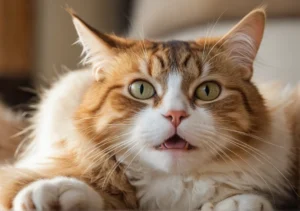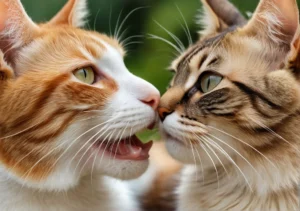Cats are known for their mysterious and sometimes unpredictable behavior. One moment they’re purring contently in your lap, the next they’re giving you a little nibble. Have you ever wondered, “Why does a cat mrrp bite?”
Cats use biting as a form of communication and expression.
Instinctual Behavior
Cats have natural instincts that can sometimes lead to biting behavior. Hunting instincts are deeply ingrained in cats, so they may bite as a way of preparing prey or protecting themselves. When a cat mrrps and then nibbles or bites, it could be a leftover instinct from their wild ancestors. In these situations, it’s important to provide appropriate outlets for their energy and play. Making sure your cat has toys or interactive games can help redirect their instincts in a positive way.
Additionally, territorial instincts can also come into play. If a cat feels threatened or uneasy, they may resort to biting as a way to defend their space. Creating a safe and comfortable environment for your cat can minimize these instincts and help prevent biting behaviors. Understanding your cat’s natural inclinations can help you work with them to establish healthy boundaries and prevent unwanted biting incidents.
Playful Nature
Cats are known for their playful nature and biting can sometimes be a part of their expressions of joy during playtime. When a cat mrrps before biting during play, it could be a sign of excitement. Cats use their mouths and teeth to explore the world around them, including during play. However, it’s essential to teach your cat appropriate play behavior to avoid unintentional harm. Investing in soft toys or interactive wands can provide a safe outlet for your cat’s playful instincts without the risk of accidental bites.
One unique aspect of a cat’s playful biting behavior is the social learning aspect. Cats often mimic behaviors they see other cats or even humans do. If a cat has been encouraged to use biting behavior during play in the past, they may continue this pattern. Setting clear boundaries and consistently reinforcing positive play behaviors can help your cat understand what is acceptable during playtime. By engaging in interactive play with your cat and providing appropriate toys, you can foster a healthy play relationship without the need for biting.
Warning Signs
Cats communicate through various types of bites, such as gentle nibbles or firm nips. When feeling threatened or uncomfortable, a cat may resort to biting as a way to convey their emotions. Keep an eye out for warning signs like flattened ears, dilated pupils, or a twitching tail, as these indicate that your cat may be feeling agitated. It’s essential to respect your cat’s boundaries and give them space when they display these signs to prevent getting bitten.
Teething can also play a role in a cat’s biting behavior. Kittens typically begin teething around 3-4 months old, which can cause discomfort and lead to increased chewing and biting. Providing your kitten with appropriate chew toys can help alleviate their teething pain and prevent them from biting on inappropriate items, like furniture or your hands. Remember to be patient and understanding during this phase, as it is a natural part of their development.
Additional unique insight: Redirecting your cat’s biting behavior towards appropriate toys and activities can help reinforce positive habits and discourage biting. Introduce interactive toys or puzzles that engage your cat’s hunting instincts, providing them with mental stimulation and physical exercise while keeping their biting tendencies in check.
Teething
Teething is a natural process that all kittens go through, typically starting around 3-4 months old. During this period, kittens may experience discomfort in their gums, leading to increased chewing and biting behavior. It’s important to provide your kitten with appropriate teething toys to help soothe their gums and satisfy their urge to chew. Avoid using your hands or fingers as chew toys to prevent reinforcing biting behavior towards people.
Teething can influence a cat’s biting behavior, as they may seek relief from their discomfort by chewing on objects or even biting. By understanding this process and providing your kitten with the necessary tools to navigate it, you can help them transition through teething without developing problematic biting habits. Remember to be patient and consistent in redirecting their biting behavior towards appropriate items, such as chew toys or scratching posts.
For more information on teething in cats and how to help alleviate your kitten’s discomfort during this stage, you can refer to this helpful resource.
Attention Seeking
When your cat mrrps and then bites, it might be trying to grab your attention. Cats can resort to biting as a way to communicate their needs, whether they want to play, be fed, or simply receive some affection. To redirect this behavior, it’s essential to provide alternative ways for your cat to interact with you. Ensure your cat has plenty of toys to play with, engage in interactive play sessions, and establish a routine for feeding and affection. By meeting your cat’s needs proactively, you can help prevent mrrping and biting as attention-seeking behaviors.
Socialization
Proper socialization is crucial for preventing excessive biting habits in cats. When kittens are young, they learn how to interact with others through play and observation. If a kitten isn’t properly socialized, it may develop biting habits as it grows older. To promote good socialization in your cat, offer positive reinforcement for good behavior, provide plenty of opportunities for social interaction with humans and other animals, and create a stimulating environment with toys and activities. By encouraging positive social interactions early on, you can help your cat develop healthy social skills and reduce the likelihood of biting behavior.
Additional Unique Insight: Cats that are not properly socialized as kittens may exhibit fear-based aggression, leading to biting as a defense mechanism. Helping these cats build confidence through positive reinforcement and gradual exposure to new experiences can reduce fear-based biting behaviors.
Remember, understanding why your cat mrrps and bites is the first step in addressing these behaviors effectively. By providing appropriate attention and socialization, you can help your cat develop positive behaviors and strengthen your bond with them.
Training Tips
Hey there cat owners! Want to minimize those pesky biting behaviors in your furry friend? One effective trick is to never play with your cat using your hands. Instead, opt for interactive toys like feather wands or laser pointers to redirect their play aggression. Remember, consistency is key when training your kitty – so make sure to reward good behavior with treats and praise!
Interesting Facts
Did you know that when a cat mrrps and then bites, it’s actually a sign of affection? Cats use this unique form of communication to show their love and trust. It’s like their way of saying, “Hey, you’re my favorite human!” So, next time your feline friend gives you a gentle bite after a nice purr session, remember that it’s just their way of saying “I love you.”
Bonus Tip: Providing your cat with plenty of mental and physical stimulation can help reduce biting behavior. Try introducing puzzle toys or creating a fun indoor environment with climbing structures and hiding spots to keep your cat entertained and engaged.
Alex, a passionate animal lover, has experience in training and understanding animal behavior. As a proud pet parent to two dogs and three cats, he founded AnimalReport.net to share insights from animal experts and expand his knowledge of the animal kingdom.




